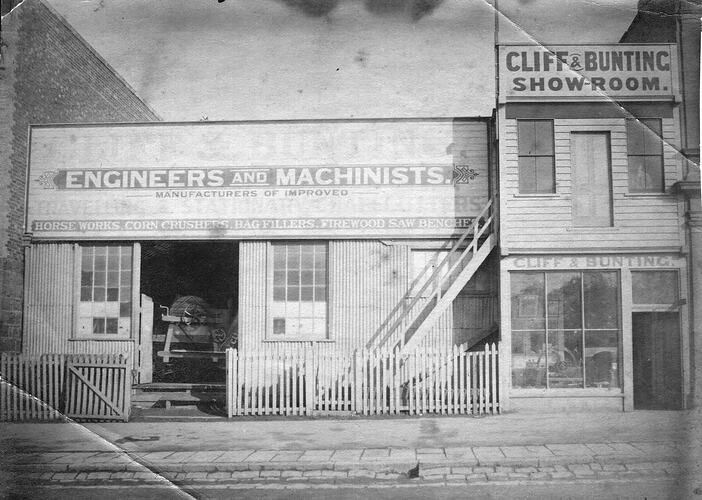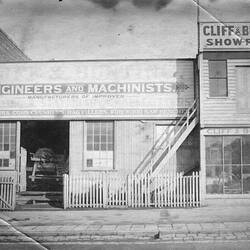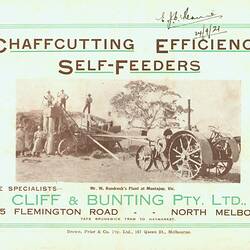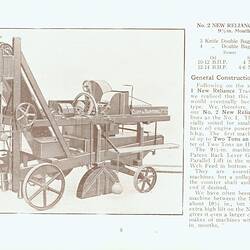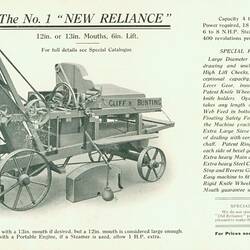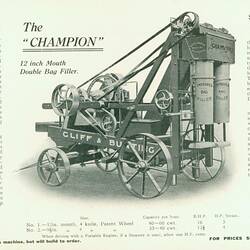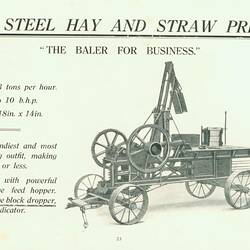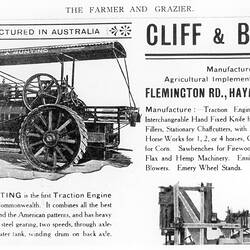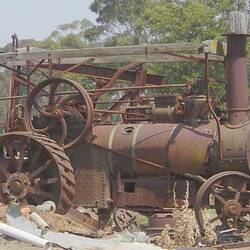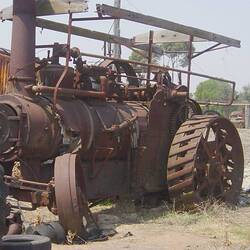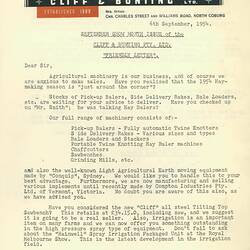The firm of Cliff & Bunting was established in mid-1888 by two Yorkshiremen Harry Cliff and Jonathan Craven Bunting. Harry had was born in 1848, in Bradford, Yorkshire, where he trained in mechanical engineering before immigrating to Victoria with his wife, Emma Jane née Wright, and their three young children in 1883. He spent the next five years working for John Buncle, one of Victoria's pioneering agricultural implement makers, and proprietor of the Parkside Ironworks at North Melbourne, established in 1854. Buncle was widely regarded as Australia's foremost chaffcutter manufacturer and had been the first to introduce a travelling chaffcutter design in 1876. Harry was credited with 'having designed many improvements' in Buncle's machinery, most notably to 'the travelling chaff-cutter with bag-filler attached', and 'the chaff bagging apparatus for stores, etc.' and became the main driving force behind product innovation with the new firm. [1]
Cliff & Bunting first exhibited at the National Agricultural Society's Annual Show held in Flemington, Melbourne, from 28th Aug-1st Sep 1888, presenting 'chaffcutters, saw-benches, and horse-gears', and the following month won first prize for their chaffcutters at the Grand National Show in St Arnaud - the first of many prizes awarded to the firm. [2]
Advertisements indicate that the firm's early product range was similar to the main types of equipment being manufactured by John Buncle - including improved travelling & stationary chaff cutters, bag fillers, horseworks*, grain crushers, firewood & carpenters' saw benches and bark cutters & disintegrators (with improved bag rammer & dust extractor). The firm also produced general machinery components such as shafting, plumber blocks, pulleys, etc., warehouse hoists and 'special machinery made to order', as well as offering to undertake 'all kinds of repairs & jobbing work'. [3]
Their first manufacturing works were situated at 159 Elizabeth Street, North Melbourne, on the west side between Victoria Street and Flemington Road, in an area where a concentration of agricultural implement and machinery manufacturers had emerged from the 1860s - set amidst related businesses such as coachbuilders, saddlers and tentmakers. In 1895, Cliff & Bunting acquired the plant, stock & good-will of one of their main competitors, John Swan & Co., who had been forced into liquidation by the recession and agricultural downturn of the early 1890s. Swan & Co was established in 1866 and by the late 1880s had developed a strong reputation as one of Victoria's two leading chaffcutter manufacturers. By the 1890s Swan & Co had diversified into a range of other agricultural machinery, including reaping machines, strippers and winnowers. Cliff & Bunting relocated their business to Swan & Co's larger premises in Blackwood Street, North Melbourne, and for a number of years continued to offer spare parts for former Swan & Co products. [4]
In 1906, Cliff & Bunting further expanded their premises opening a new office and showroom around the corner from the Blackwood Street factory, with a frontage to Flemington Road, near the Haymarket. [5]
In 1897, Cliff & Bunting released their improved "Reliance" model travelling chaff-cutter, which was the first Australia manufactured chaffcutter to feature interchangeable knife-wheels, allowing operators to keep the machine working all day without lengthy delays to re-sharpen knife blades or refit spare knife blades individually. The "Reliance" set new industry benchmarks for chaff-cutter performance, reliability and versatility, and together with the "Champion" double-bagger model released in 1904, provided the mainstay of the firm's business over the next 50 years. [6]
By 1900, Cliff & Bunting were offering imported American-built steam traction engines for sale in combination with their own travelling chaffcutters, sourcing initially 'Eclipse' brand traction engines manufactured by Frick & Co., of Waynesboro, Pennsylvania, then from 1902, 'Kelly' traction engines made by the O.S. Kelly Manufcturing Co., of Springfield, Ohio. Their experience selling these light weight engines against much heavier English-built traction engines would significantly influence Cliff & Bunting, when in 1907, they became the first Australian firm to offer a locally-made traction engine of their own design. [7]
By 1910, Cliff & Bunting had emerged as Australia's leading manufacturer of chaffcutters out selling both old rivals like John Buncle & Sons, of North Melbourne, and larger more general agricultural implement manufacturers like H.V. McKay and T. Robinson & Co.. The company introduced further improvements in the "New Reliance" model of 1911 and the smaller "Farmer's Friend" and continued to innovate over subsequent decades, taking out numerous patents. [6]
John C. Bunting retired from the firm on 31 December 1911, with the business continuing under the same title with Harry Cliff and his son Francis (Frank) Ernest Cliff as proprietors, before being incorporated as Cliff & Bunting Pty Ltd in 1915. [8]
By 1919, Cliff & Bunting were also marketing their own brand of small petrol and diesel engines, which they continued to make in small batches until around the 1940s. In later years the firm also built garden spray units, hay presses and later pick-up hay balers, including models powered by their own internal combustion engines. Cliff & Bunting remained Australia's leading manufacturer of chaffcutters until the downturn in horsedrawn transport and working farm horses after the Second World War led to a decline in demand for chaff.
Founder Harry Cliff, died at his home "Mymiami", Cliff Street, Essendon, on the evening of 7th November 1928, at 80 years of age. His former partner, Jonathan Craven Bunting, died at St Kilda, Victoria, on 3rd November 1947, aged 85 years. Both men had been actively involved with the Royal Agricultural Society of Victoria and the running of the Royal Melbourne Show over many decades. [9]
During the Second World War, Cliff & Bunting diversified into the manufacture of electric power transformers under the "Trimax" brandname. In 1947, the firm relocated their manufacturing operations to a site on the corner of Charles Street and Williams Road, North Coburg, where half the new factory was used for the manufacture of agricultural equipment and the other half for Trimax Transformers. The company continued to innovate in its agricultural product lines, introducing automatic pick-up balers, a self-typing mechanism for their balers and engine-functioned machines, but demand for chaff-cutters was declining and they produced their last new chaffcutter in 1955.
Less than a year later the agricultural division of Cliff & Bunting was taken over by the Baltic Simplex Machinery Company, who continued to operate for another 25 years offering spare parts and repairs on Cliff & Bunting equipment. In 1964 the "Cliff & Bunting" brandname became part of the large South Australian based agricultural implement manufacturer, Horwood Bagshaw Ltd. Spare parts for Cliff & Bunting machines continue to be available today, currently being made and sold through Dickens Engineers, of Corowa, New South Wales, attesting to the durability of the original Cliff & Bunting designs.
* Horseworks (also known as 'horse gears' or 'horse powers') were widely used on smaller farms for driving agricultural machinery before the advent of the internal combustion engine.
References:
1. 'Cliff and Bunting', Weekly Times (Melbourne), 1 Sep 1888, p.10 (Supplement Special Machinery), from http://nla.gov.au/nla.news-article220412639.
2. 'National Agricultural Show', The Age (Melbourne), 29 Aug 1888, p.9, from http://nla.gov.au/nla.news-article196004997 ; 'The National Show', Bendigo Advertiser, 28 Sep 1888, p.2, from http://nla.gov.au/nla.news-article88554887 ; 'Messrs. Cliff And Bunting', The Leader Supplement (Melbourne), 31 Aug 1889, p.3, from http://nla.gov.au/nla.news-article198058106.
3. [Advertising], Weekly Times (Melbourne), 25 Aug 1888, p.3, from http://nla.gov.au/nla.news-article220410024.
4. [Advertising], Ovens & Murray Advertiser (Beechworth), 19 Jan 1895, p.2, from http://nla.gov.au/nla.news-article201542678 ; 'Cliff and Bunting', The Leader Supplement (Melbourne), 31 Aug 1895, p.15, from http://nla.gov.au/nla.news-article196412283 ; 'Messrs Cliff and Bunting', Weekly Times Supplement (Melbourne), 5 Sep 1896, p.3, from http://nla.gov.au/nla.news-article221204338.
5. 'Messrs. Cliff & Bunting's New Show Rooms', North Melbourne Courier & West Melbourne Advertiser, 10 Aug 1906, p.3, from http://nla.gov.au/nla.news-article108830746.
6. Cliff & Bunting Catalogues & Price Lists, Trade Literature Collection, Museums Victoria.
7. [Advertising], The Australasian Supplement (Melbourne), 8 Sep 1900, p.3, from http://nla.gov.au/nla.news-article139155256 ; 'Cliff and Bunting', Leader - Agricultural Supplement (Melbourne), 8 Sep 1900, p.7, from http://nla.gov.au/nla.news-article198180618 ; 'Cliff & Bunting', Weekly Times (Melbourne), 6 Sep 1902, p.11 (Royal Easter Show Supplement), from http://nla.gov.au/nla.news-article221234059 ; 'Australian Traction Engine', Weekly Times (Melbourne), 31 Aug 1907, pp.28 & 33, from http://nla.gov.au/nla.news-article221260297 ; 'An Australian-Made Traction Engine', Leader (Melbourne), 31 Aug 1907, p.30, from http://nla.gov.au/nla.news-article198103293 ; 'Australian Traction Engine', The Australasian (Melbourne), 31 Aug 1907, p.8, from http://nla.gov.au/nla.news-article139277130 & p.35, from http://nla.gov.au/nla.news-article139277202 ; M.S. Churchward, The Victorian Steam Heritage Register, Scienceworks, Museum of Victoria, 1994.
8. 'Notice of Dissolution', Victorian Government Gazette, 29 Dec 1911, Issue 191, p.6114.
9. 'Family Notices', The Age (Melbourne), 9 Nov 1928, p.1, from http://nla.gov.au/nla.news-article204252807; 'Obituary', The Age (Melbourne), 5 Aug 1947, p.2, from http://nla.gov.au/nla.news-article206044905.
More Information
-
Keywords
-
Localities
-
Authors
-
Article types
